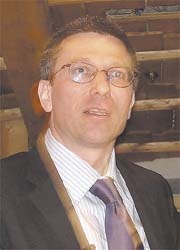New insights, algorithms and debates
By Dieter O Mayer MD, of Zurich University Hospital, Switzerland
For the first time in 33 years, wound healing was the focus of a dedicated session at the 33rd annual VEITHsymposium for vascular surgeons in New York (11/06). This underscores the fact that wound healing is heading increasingly towards a speciality that warrants the special attention of dedicated people willing to embrace an interdisciplinary approach to non-healing or complex wounds.

Wounds at VEITHsymposium, organised and co-chaired by myself, with Gary W Gibbons, of Boston, MA, and David L Steed, of Pennsylvania, was subdivided into 6 sections. (1) New Concepts in Wound Care. (2) Classic versus Modern Wound Care. (3) Wound Healing Societies. (4) Silver in Wound Care – The Magic Bullet? (5) Economy in Wound Care. (6) The Diabetic Foot.
In Section 1, R Gary Sibbald (Toronto, Canada and Gregory Schultz, Gainesville, FL, USA pointed out the importance of having a conceptual rather than a straightforward local approach to all types of wounds: physicians should always search for an accurate diagnosis and treat the cause (see diagram 1) as well as take into account the patient-centred concerns, such as experience, ability to co-operate and preferences; only then should physicians and nurses start to focus on local wound care. The TIME concept (diagram 2 and 3) illustrates the systematic (modern) approach to local wound care. E Sebastian Debus (Hamburg, Germany) and Dieter O. Mayer focused on two further topics, quality of life (QoL) and 3-dimensional (3D) measurement of wound healing; QoL was significantly reduced in ulcer patients and 3D measurement of wounds was the only accurate parameter of wound healing over time. Anneke Andriessen (Malden, The Netherlands) presented the approach of German speaking countries on wound antisepsis (consensus paper).
Section 2 covered discussion about classic versus modern wound care. Martin C Robson, (Tampa, Florida), Michael G. Franz (Ann Arbor, Missouri) and David L Steed, made it clear that, although modern wound care has made huge progresses over the last years, clear evidence for superiority is still lacking for most of the modern wound therapies.
In section 3, R Gary Sibbald presented the World Union of Wound Healing Societies (WUWHS) and the 2008 meeting in Toronto, Canada, where about 6,000 participants are expected. The meeting is highly recommended for all who are co-involved in wound healing.
Section 4 focused on silver (Ag) in wound healing. Liza G Ovington (Sommerville, New Jersey) and Robert E Burrell (Edmonton, Alberta) fought out the battle for whether the different forms of silver (nano-crystalline (NC) versus non-NC) might have a different impact on wound healing. Again, it was shown that all forms of Ag are effective, with little evidence on which type of treatment is better. In any case, Ag dressings were shown to be effective even in the topical treatment of MRSA and in the presence of biofilms by J Barry Wright, (Collegeville, Pennsylvania) and Robert Strohal (Feldkirch, Austria). Steven Percival (Deeside, UK) demonstrated that the prevalence of resistance of micro-organisms to Ag is very low and clinically irrelevant, probably due to its multiple site of action.
In Section 5, Michael S Weingarten (Philadelphia, PA) and Robert E Burrel showed that modern wound dressings probably will be cost effective compared with classic wound care, although evidence-based data for this topic are also unavailable. Christopher E Attinger (Washington, DC) showed how best to invoice for wound care after vascular surgery.
Section 6, on the diabetic foot, debated whether osteomyelitis would need a radical resection or not, Thomas Boeni (Zurich, Switzerland) showed that, in special circumstances, a conservative approach might be a valuable alternative compared with radical resection. Nevertheless, radical resection (as little as possible) is still the mainstay to treat diabetic foot infection with bone involvement, as pointed out by Gary W Gibbons. Tools, such as the vacuum assisted closure (VAC) system and hyperbaric oxygen therapy, presented by Dieter O Mayer and Palma M.Shaw (Boston, MA) have been shown to have great potential, although evidence exists only for the VAC system.
The WOUNDS at VEITHsymposium 2006 was conceived as a unique, physician-centred top quality focus meeting about wound healing and indicated the future direction of an evolving speciality. Dedicated people willing to share their knowledge and to participate in an interdisciplinary, as well as inter-professional, approach to patients with wound healing problems, will be able to further strengthen the evidence of modern wound care and therapeutics.
Additional details: www.veithsymposium.org
26.06.2007











